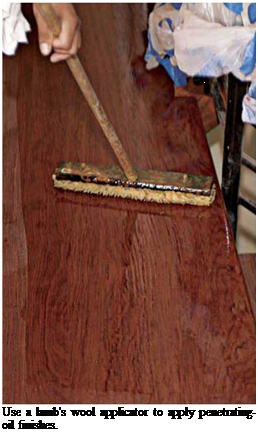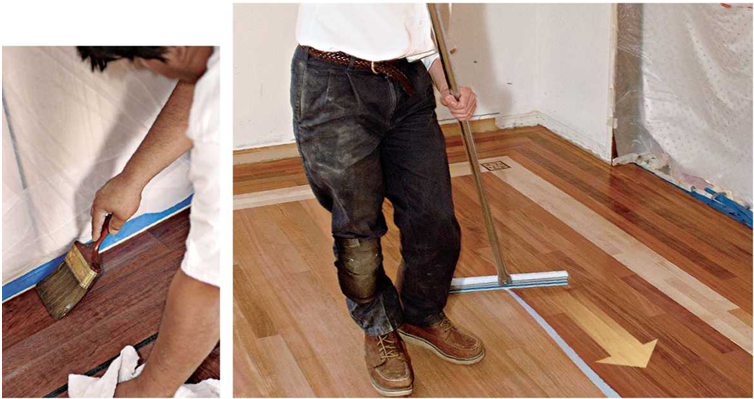SELECTING A FLOOR FINISH
Floor finishes are often divided into two categories: penetrating sealers (penetrants) and surface finishes. Penetrating sealers usually contain plant-based oils, such as tung oil or modified linseed oil, and soak into wood fiber. In time, they harden to seal and protect the wood. Because penetrating sealers form a hard outer shell, they can be easier to touch up by sanding lightly and adding more sealer if wood becomes scuffed or scratches—touched-up areas won’t be obvious. Wood stains penetrate and don’t really seal.
When they have dried, penetrating sealers are often waxed to make them more durable. But waxed floors are durable only if they’re regularly maintained, which takes time. Thus most floors today are sealed with surface finishes, which don’t require waxing.
Surface finishes, as their name implies, form a tough exterior shell to resist scuffs, scratches, and moisture. The earliest surface finishes were shellac and varnish, which have been largely replaced by oil-based and water-based polyurethanes. Shellac has poor water resistance and chips easily, and varnishes tend to be strong smelling and slow to dry. Besides, both are extremely flammable. Although surface finishes require less maintenance, their disadvantage is that they can’t be touched up when they become worn, so you must refinish the whole floor. Surface-finish sheens range from matte (little shine) to satin to semigloss to gloss. In general, glossier finishes are harder, more durable, and more water resistant.
As you’ll see, polyurethanes vary greatly in ease of installation, drying time, and durability. Water-based polyurethanes are the stars of the show these days: tough, nonyellowing, relatively mild smelling, and fast drying (2 hours to 6 hours). And brush cleanup is easy with soap and water. Because they contain lower levels of
volatile organic compounds (VOCs), water based polyurethanes are also safer to use. Despite their volatility, oil-based polyurethanes are often applied by professional refinishers because they’re slower to dry and thus allow more time to even out coats. Though solvent based and stronger smelling, oil-based polys are more durable and water resistant, and they turn a handsome amber with age. Let them dry for 24 hours before recoating or walking on them. Moisture-cure polyurethanes are the most durable of the lot; but because they must absorb moisture from the air, they’re temperamental to apply, slow to dry, and best left to professionals.
Finally, there are surface finishes that require highly controlled environments and thus are factory applied to prefinished flooring. This group of finishes may include aluminum-oxide, titanium, or ceramic additives to resist abrasion and may require UV curing, rather than heat cur-


ing. Some of the toughest of these finishes infuse acrylic into the wood cells in a modern version of a penetrating sealer.






Leave a reply